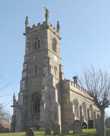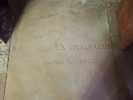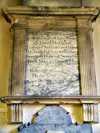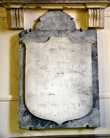For this church:    |
|
Key to Monuments |
1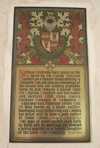 Memorial
Brass with Coat of Arms
Memorial
Brass with Coat of Arms
This brass commemorates the presentation of the flanking windows by Sir George William Craufurd:
... as a humble thank-offering to Almighty God, and also as a memorial of the earnest love and undying gratitude borne by him towards a revered uncle Sir Charles Craufurd and his noble and excellent wife, Anna Maria, Duchess Dowager of Newcastle
Anna Maria, widow of the 3rd Duke of Newcastle, (née Stanhope-Harrington) resided at Ranby Hall, Nottinghamshire until her death on 18th October 1834 – an event described by the 4th Duke of Newcastle in his diary.
Sir Charles Craufurd died in 1821 and is buried in Bothamsall church. He had pursued a distinguished military career reaching the rank of major general; being at one time ADC to the Duke of York in the period of the Napoleonic Wars. Sir George William Craufurd was vicar of Burgh-le-Marsh, Lincolnshire from 1838-46. He had Burgh Hall built in 1840. Unfortunately he did not choose to have a date put on the commemorative brass but it would be reasonable to conjecture that the stained glass in the windows was commissioned after the rebuilding of Bothamsall church in 1845.
2,3
 Visible part of one of Visible part of one ofthe chancel floorstones |
Floorstones with Crosses
Arthur Mee states that there are ‘two floorstones with crosses in the chancel’ but unfortunately the present situation is that the chancel has a firmly fixed carpet down the centre of the chancel so that little comment can be made except that, on the north side of the carpet a portion of one cross of a stepped and foliate design is visible. On the opposite side, a narrow strip of stone 15cms wide is of a corresponding stone – presumably that is the edge of the second floorstone.
4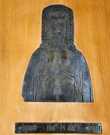 Wall
Brass
Wall
Brass
This late 14th Century brass is believed to commemorate Margaret, the daughter of Richard Buslyngthorp, knight. She died in Bothamsall on 8th August 1369, the most important landowner known to have died in the village within the period indicated by the style of the brass. Since she was a spinster, she would be commemorated by a single effigy.
The brass was discovered around 1920 when the fitting of a new high altar necessitated lifting the chancel floor. The brass figure is divorced from its matrix slab. It is not certain whether this figure is the upper half of a full length brass supplied in two parts or whether this is an entire brass. Of English workmanship, this brass is the earliest survivor of its type in the county.
It is interesting to note that a brass commemorating an ancestor, Sir Richard Buslyngthorpe, has been dated to c1310. It is probably of European origin and is still extant, being preserved in the redundant church of St Michael, Buslingthorpe, Lincolnshire. It is considered a very fine early example of a military figure.
Only a partial inscription remains:
| nono cui aic omn... |
The lost portion would almost certainly state the name and rank of the person commemorated. The black letter inscription around the border can be compared with a brass (1419) in East Markham church.
6 Raised Tomb
Raised Tomb
In 1845 the vestry was built in an area which may have been the eastern end of the north aisle. This tomb was that of Henry Walters who had been steward to the Earls of Clare. Obviously a benevolent man, in his will of 1688 he left money for male children of the villages of Bothamsall, Haughton, Elkesley, Gamston, West Drayton, Milton and Bevercotes to attend a grammar school built in 1692. He also left a pension of £5 a year each to four widows of ministers which was still being paid out in the 1930s. To Bothamsall church he gifted a silver paten. The tomb is now covered by an oak top so that it has effectively become a desk and therefore not viewable but inventory notes 1993-4 confirms it is inscribed as in memory of Henry Walters, steward to the Earls of Clare, who died in January 1689.
7 Wall Memorial
Tablets
Wall Memorial
Tablets
Three tablets are located immediately above one another at the west end of the north aisle. Details are as follows (top to bottom, though this is in reverse date order):
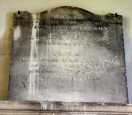 John Hugh and William Marson
John Hugh and William Marson
SACRED  ALSO OF |


